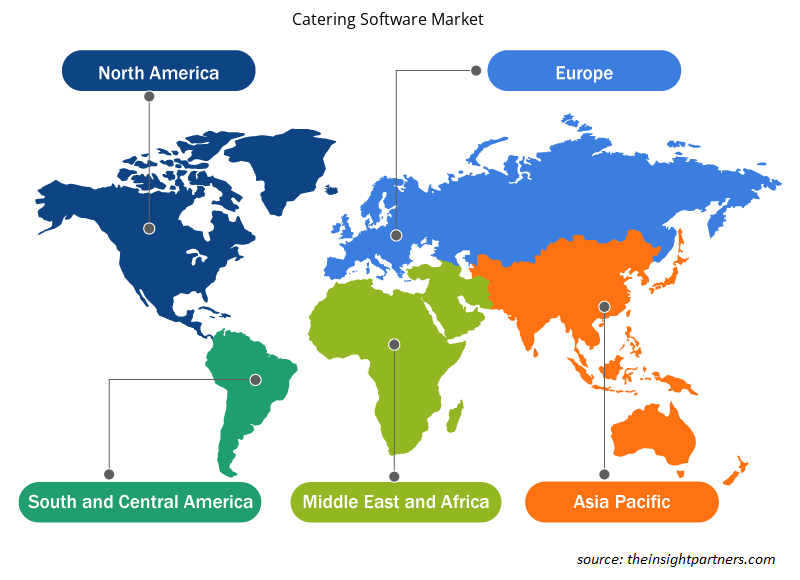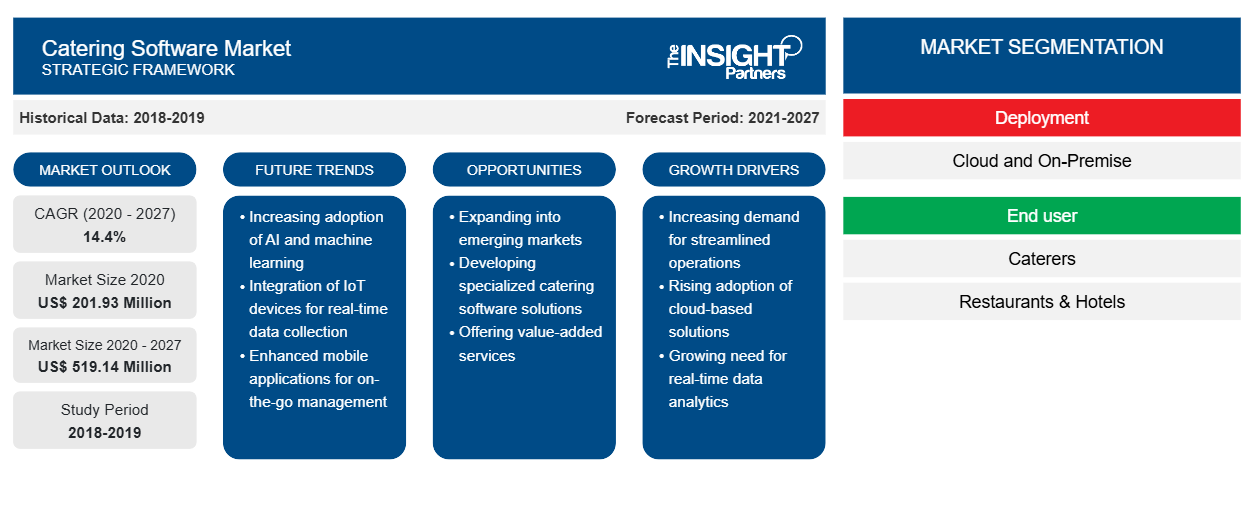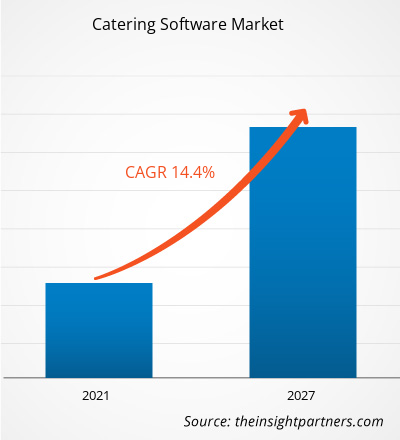Si prevede che il mercato del software per la ristorazione crescerà da 201,93 milioni di dollari nel 2020 a 519,14 milioni di dollari entro il 2027; si stima che crescerà a un CAGR del 14,4% dal 2020 al 2027.
La tecnologia di analisi dei Big Data per migliorare le operazioni di catering sta attribuendo alla crescita del mercato. La tecnologia di analisi dei Big Data ha un potenziale enorme per trasformare completamente il settore della catering. L'adozione di soluzioni Big Data aiuta a migliorare l'efficienza delle reti di distribuzione e produzione nel settore della catering in generale. La tecnologia consente di tracciare l'intero processo di trasporto delle forniture. Con informazioni in tempo reale, i clienti possono tracciare i loro ordini di acquisto sui loro dispositivi e controllare lo stato del catering. L'integrazione di una dashboard di analisi nel software di catering aiuta a tracciare e valutare le prestazioni degli agenti di catering. Inoltre, ogni stakeholder nel settore della catering deve disporre di dati rilevanti sui propri prodotti, inclusi dati relativi ad agricoltori, spedizionieri e rivenditori, per finire con ristoranti e negozi. Ad esempio, il ristorante KFC utilizza strumenti Big Data per analizzare il feedback dei clienti e le preferenze alimentari, portando a migliori esperienze dei clienti, vendite e profitti.
Il settore dell'e-commerce in tutte le regioni ha assistito a numerose trasformazioni negli ultimi anni; la crescita del settore ha spinto gli operatori del mercato del software di catering a sfruttare l'analisi dei Big Data per prendere decisioni aziendali più intelligenti. La tecnologia consente ai rivenditori online di valutare le interazioni con i clienti attraverso canali quali dispositivi mobili, social media e siti Web.
Personalizza questo report in base alle tue esigenze
Riceverai la personalizzazione gratuita di qualsiasi report, comprese parti di questo report, o analisi a livello nazionale, pacchetto dati Excel, oltre a usufruire di grandi offerte e sconti per start-up e università
- Scopri le principali tendenze di mercato in questo rapporto.Questo campione GRATUITO includerà analisi di dati che spaziano dalle tendenze di mercato alle stime e alle previsioni.
Impatto della pandemia di COVID-19 sul mercato del software di ristorazione
In seguito allo scoppio globale della pandemia di COVID-19, alcune aziende sono state costrette a ridimensionare le proprie attività a causa di varie misure di contenimento emanate dai governi di tutto il mondo. La rapida diffusione del virus ha spinto i governi di tutto il mondo a imporre severe restrizioni alla circolazione di persone e veicoli. Le aziende che si affidano all'interazione fisica per generare fatturato sono state gravemente danneggiate dai lockdown. Di conseguenza, alcune aziende si stanno concentrando sull'aumento di conversioni, interazioni e fatturato tramite i media digitali.
Approfondimenti di mercato – Mercato del software di ristorazione
Machine Learning per rivoluzionare il business della ristorazione
Nel settore della ristorazione, l'inadeguatezza della mappatura delle aree e lo squilibrio tra domanda e disponibilità di risorse portano a diverse sfide. L'apprendimento automatico e l'intelligenza artificiale (IA) sono le basi delle tecnologie di ristorazione di prossima generazione. Queste tecnologie consentono ai sistemi di apprendere dai dati registrati, che comprendono algoritmi, modelli e approfondimenti predittivi. Diverse aziende di consegna di cibo online stanno adottando la tecnologia di apprendimento automatico per migliorare la propria attività di ristorazione e aumentare l'efficienza delle proprie attività. Ad esempio, Deliveroo, un'azienda di consegna di cibo con sede nel Regno Unito, investe in tecnologie avanzate come l'apprendimento automatico per rimanere competitiva sul mercato offrendo un servizio di consegna di cibo più efficace. Glovo, un'azienda di consegna di cibo con sede in Spagna, utilizza anche l'apprendimento automatico per prevedere la probabilità di rimanere attivi sull'app. Pertanto, si prevede che l'integrazione dell'apprendimento automatico nelle attività di ristorazione aumenterà la domanda di software di ristorazione durante il periodo di previsione.
Informazioni basate sulla distribuzione
In base al tipo di distribuzione, il mercato del software di catering è segmentato in cloud e on-premise. Il segmento cloud ha detenuto la quota di mercato maggiore nel 2019.
Approfondimenti regionali sul mercato del software per la ristorazione
Le tendenze regionali e i fattori che influenzano il mercato del software per la ristorazione durante il periodo di previsione sono stati ampiamente spiegati dagli analisti di Insight Partners. Questa sezione discute anche i segmenti e la geografia del mercato del software per la ristorazione in Nord America, Europa, Asia Pacifico, Medio Oriente e Africa e America meridionale e centrale.

- Ottieni i dati specifici regionali per il mercato del software di catering
Ambito del rapporto di mercato del software di catering
| Attributo del report | Dettagli |
|---|---|
| Dimensioni del mercato nel 2020 | 201,93 milioni di dollari USA |
| Dimensioni del mercato entro il 2027 | 519,14 milioni di dollari USA |
| CAGR globale (2020 - 2027) | 14,4% |
| Dati storici | 2018-2019 |
| Periodo di previsione | 2021-2027 |
| Segmenti coperti | Per distribuzione
|
| Regioni e Paesi coperti | America del Nord
|
| Leader di mercato e profili aziendali chiave |
|
Densità dei player del mercato del software di catering: comprendere il suo impatto sulle dinamiche aziendali
Il mercato del software per la ristorazione sta crescendo rapidamente, spinto dalla crescente domanda degli utenti finali dovuta a fattori quali l'evoluzione delle preferenze dei consumatori, i progressi tecnologici e una maggiore consapevolezza dei vantaggi del prodotto. Con l'aumento della domanda, le aziende stanno ampliando le loro offerte, innovando per soddisfare le esigenze dei consumatori e capitalizzando sulle tendenze emergenti, il che alimenta ulteriormente la crescita del mercato.
La densità degli operatori di mercato si riferisce alla distribuzione di aziende o società che operano in un particolare mercato o settore. Indica quanti concorrenti (operatori di mercato) sono presenti in un dato spazio di mercato in relazione alle sue dimensioni o al valore di mercato totale.
Le principali aziende che operano nel mercato del software per la ristorazione sono:
- Azienda
- Migliore catering, Inc.
- Software di Caterase
- CaterTrax, Inc.
- CaterZen di Sistemi per ristoranti e catering
Disclaimer : le aziende elencate sopra non sono classificate secondo un ordine particolare.

- Ottieni la panoramica dei principali attori del mercato del software di catering
Gli operatori che operano nel mercato del software per la ristorazione si concentrano principalmente sullo sviluppo di prodotti avanzati ed efficienti.
- Nel 2020, CaterZen ha investito ore di programmazione dall'inizio di marzo per confermare che ristoranti e servizi di catering possano continuare le attività concentrandosi fortemente sugli ordini online e sulla consegna di cibo.
- Nel 2020, Flex Catering ha introdotto il sistema di visualizzazione della cucina (KDS) per il catering, un tipo di schermo digitale che sostituisce gli ordini cartacei o scritti a mano nei ristoranti e nelle attività alimentari.
Il mercato del software per la ristorazione è stato segmentato come segue:
Software di ristorazione globale - Per distribuzione
- Nuvola
- In sede
Software di ristorazione globale - Per utente finale
- Ristoratori
- Ristoranti e Hotel
- Altri
Mercato globale del software di ristorazione – per area geografica
America del Nord
- NOI
- Canada
- Messico
Europa
- Francia
- Germania
- Italia
- Russia
- Regno Unito
- Resto d'Europa
Asia Pacifico (APAC)
- Giappone
- Cina
- Australia
- India
- Corea del Sud
- Resto dell'APAC
Medio Oriente e Africa (MEA)
- Arabia Saudita
- Emirati Arabi Uniti
- Sudafrica
- Resto del MEA
America del Sud (SAM)
- Brasile
- Argentina
- Resto del SAM
Mercato del software per la ristorazione – Profili aziendali
- Azienda
- Migliore catering, Inc.
- Software di Caterase
- CaterTrax, Inc.
- CaterZen di Sistemi per ristoranti e catering
- Ristorazione flessibile
- Software di ristorazione FoodStorm (CaterXpress)
- Pod di pianificazione (My Wedding Workbook, LLC)
- Sistemi di profitto Inc.
- Più folletto
- Analisi storica (2 anni), anno base, previsione (7 anni) con CAGR
- Analisi PEST e SWOT
- Valore/volume delle dimensioni del mercato - Globale, regionale, nazionale
- Industria e panorama competitivo
- Set di dati Excel



Report Coverage
Revenue forecast, Company Analysis, Industry landscape, Growth factors, and Trends

Segment Covered
This text is related
to segments covered.

Regional Scope
North America, Europe, Asia Pacific, Middle East & Africa, South & Central America

Country Scope
This text is related
to country scope.
Domande frequenti
The catering software market is led by cloud segment with highest share and is expected to dominate in the forecast period. The cloud segment generates the majority of the demand since it is comparatively less expensive and due to strong network infrastructure in developed countries. In addition, the cloud-based browser isolation software vendors are highly focused on developing a high-level security patch in order to eliminate the risk of cyber-attack.
The growth of the catering software market is primarily attributed to growing popularity of e-commerce platforms. Moreover, increasing integration of payment gateway, thereby substantially driving the catering software software market.
The Big Data analytics technology has enormous potential to completely transform the catering business. The adoption of Big Data solutions helps improve the efficiency of distribution and production networks in the overall catering industry. The technology allows tracking the entire process of the transportation of supplies. With real-time insights, customers can track their purchase orders on their devices and check the catering status. The integration of an analytics dashboard in catering software helps track and evaluate the performance of catering agents. Also, every stakeholder in the catering business must have relevant data on their products, including data related to farmers, shippers, and retailers, ending with restaurants and shops.
Trends and growth analysis reports related to Technology, Media and Telecommunications : READ MORE..
The List Companies - Catering Software Market
- Aptus Systems Ltd.
- Better Cater, Inc
- Caterease Software
- CaterTrax, Inc.
- CaterZen by Restaurant & Catering Systems
- Flex Catering
- FoodStorm Catering Software (CaterXpress)
- Planning Pod (My Wedding Workbook, LLC)
- Profit Systems Inc.
- Pxier
The Insight Partners performs research in 4 major stages: Data Collection & Secondary Research, Primary Research, Data Analysis and Data Triangulation & Final Review.
- Data Collection and Secondary Research:
As a market research and consulting firm operating from a decade, we have published and advised several client across the globe. First step for any study will start with an assessment of currently available data and insights from existing reports. Further, historical and current market information is collected from Investor Presentations, Annual Reports, SEC Filings, etc., and other information related to company’s performance and market positioning are gathered from Paid Databases (Factiva, Hoovers, and Reuters) and various other publications available in public domain.
Several associations trade associates, technical forums, institutes, societies and organization are accessed to gain technical as well as market related insights through their publications such as research papers, blogs and press releases related to the studies are referred to get cues about the market. Further, white papers, journals, magazines, and other news articles published in last 3 years are scrutinized and analyzed to understand the current market trends.
- Primary Research:
The primarily interview analysis comprise of data obtained from industry participants interview and answers to survey questions gathered by in-house primary team.
For primary research, interviews are conducted with industry experts/CEOs/Marketing Managers/VPs/Subject Matter Experts from both demand and supply side to get a 360-degree view of the market. The primary team conducts several interviews based on the complexity of the markets to understand the various market trends and dynamics which makes research more credible and precise.
A typical research interview fulfils the following functions:
- Provides first-hand information on the market size, market trends, growth trends, competitive landscape, and outlook
- Validates and strengthens in-house secondary research findings
- Develops the analysis team’s expertise and market understanding
Primary research involves email interactions and telephone interviews for each market, category, segment, and sub-segment across geographies. The participants who typically take part in such a process include, but are not limited to:
- Industry participants: VPs, business development managers, market intelligence managers and national sales managers
- Outside experts: Valuation experts, research analysts and key opinion leaders specializing in the electronics and semiconductor industry.
Below is the breakup of our primary respondents by company, designation, and region:

Once we receive the confirmation from primary research sources or primary respondents, we finalize the base year market estimation and forecast the data as per the macroeconomic and microeconomic factors assessed during data collection.
- Data Analysis:
Once data is validated through both secondary as well as primary respondents, we finalize the market estimations by hypothesis formulation and factor analysis at regional and country level.
- Macro-Economic Factor Analysis:
We analyse macroeconomic indicators such the gross domestic product (GDP), increase in the demand for goods and services across industries, technological advancement, regional economic growth, governmental policies, the influence of COVID-19, PEST analysis, and other aspects. This analysis aids in setting benchmarks for various nations/regions and approximating market splits. Additionally, the general trend of the aforementioned components aid in determining the market's development possibilities.
- Country Level Data:
Various factors that are especially aligned to the country are taken into account to determine the market size for a certain area and country, including the presence of vendors, such as headquarters and offices, the country's GDP, demand patterns, and industry growth. To comprehend the market dynamics for the nation, a number of growth variables, inhibitors, application areas, and current market trends are researched. The aforementioned elements aid in determining the country's overall market's growth potential.
- Company Profile:
The “Table of Contents” is formulated by listing and analyzing more than 25 - 30 companies operating in the market ecosystem across geographies. However, we profile only 10 companies as a standard practice in our syndicate reports. These 10 companies comprise leading, emerging, and regional players. Nonetheless, our analysis is not restricted to the 10 listed companies, we also analyze other companies present in the market to develop a holistic view and understand the prevailing trends. The “Company Profiles” section in the report covers key facts, business description, products & services, financial information, SWOT analysis, and key developments. The financial information presented is extracted from the annual reports and official documents of the publicly listed companies. Upon collecting the information for the sections of respective companies, we verify them via various primary sources and then compile the data in respective company profiles. The company level information helps us in deriving the base number as well as in forecasting the market size.
- Developing Base Number:
Aggregation of sales statistics (2020-2022) and macro-economic factor, and other secondary and primary research insights are utilized to arrive at base number and related market shares for 2022. The data gaps are identified in this step and relevant market data is analyzed, collected from paid primary interviews or databases. On finalizing the base year market size, forecasts are developed on the basis of macro-economic, industry and market growth factors and company level analysis.
- Data Triangulation and Final Review:
The market findings and base year market size calculations are validated from supply as well as demand side. Demand side validations are based on macro-economic factor analysis and benchmarks for respective regions and countries. In case of supply side validations, revenues of major companies are estimated (in case not available) based on industry benchmark, approximate number of employees, product portfolio, and primary interviews revenues are gathered. Further revenue from target product/service segment is assessed to avoid overshooting of market statistics. In case of heavy deviations between supply and demand side values, all thes steps are repeated to achieve synchronization.
We follow an iterative model, wherein we share our research findings with Subject Matter Experts (SME’s) and Key Opinion Leaders (KOLs) until consensus view of the market is not formulated – this model negates any drastic deviation in the opinions of experts. Only validated and universally acceptable research findings are quoted in our reports.
We have important check points that we use to validate our research findings – which we call – data triangulation, where we validate the information, we generate from secondary sources with primary interviews and then we re-validate with our internal data bases and Subject matter experts. This comprehensive model enables us to deliver high quality, reliable data in shortest possible time.


 Ottieni un campione gratuito per questo repot
Ottieni un campione gratuito per questo repot